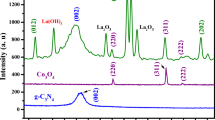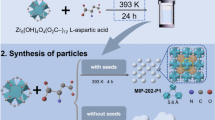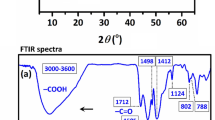Abstract
Removal of trace heavy metal ions puts high demands on designing adsorbents with favorable surfaces. Crystal-plane engineering can provide controllable adsorption energy between surficial planes and adsorbents. Herein, we have creatively synthesized Mg-doped CaCO3 nanoarchitectures assembled by layered sheets (Mg-CaCO3 LSs) with high-index facets of (\(4\overline{41}\)) through a facile wet chemical process. Adsorption tests reveal that the layer-by-layer assembled sample exhibits a maximum Pb(II) adsorption capacity of 1961.9 mg·g−1, agreeing with the monolayer-adsorption Langmuir model. At an initial Pb(II) ion concentration of 20 mg·L−1, the adsorption can achieve a high removal rate near 99.0% within 1 min, and the adsorption kinetics follows a chemisorption pseudo-second-order model. Interestingly, the Mg-CaCO3 LSs show much-improved adsorption properties towards low-concentration Pb(II) ions, which could reduce the concentration from 1 mg·L−1 to ~ 2.9 μg·L−1 in 3 h (within 30 min decrease to less than 10 μg·L−1, meeting drinking water standard from WHO). For comparison, the commercial CaCO3 and collected CaCO3 scale show much lower adsorption values with Pb(II) ion residual concentration of ~ 935.0 and ~ 944.9 μg·L−1 in 3 h, respectively. X-ray diffraction (XRD), energy dispersive spectroscopy (EDS), and inductively coupled plasma (ICP) characterizations on the Mg-CaCO3 LSs before and after adsorbing Pb(II) confirm that the high removal performance could be ascribed to fast metal ion exchange and excellent physical adsorption contributed by high-index planes. The density functional theory (DFT) calculations also confirm that the much-enhanced adsorption kinetics benefits from the optimal adsorption of the (\(4\overline{41}\)) planes. This work will provide a feasible route to design high-efficient low-cost adsorbents through crystal-plane engineering.
Graphical abstract

摘要
有效去除水中痕量重金属离子对吸附剂的结构设计提出了很高的要求。利用晶面构建工程对催 化剂结构进行设计是一个有效地解决方法。在本工作中,我们通过湿化学合成法,制备了由(\(4\overline{41}\)) 高指数面组装的 Mg 掺杂 CaCO3 纳米结构(Mg-CaCO3 LSs)。实验结果证明,层状组装结构 的Mg-CaCO3LSs对Pb(II)的最大吸附容量为1961.9 mg·g-1, 并符合单层Langmuir 吸附模型。当 Pb(II)的初始浓度为20 mg·L-1时, Mg-CaCO3 LSs表现出接近于99%的去除效率(吸附时间为1 min)。该吸附动力学过程遵循化学吸附准二级动力学模型方程。同时,在极低Pb(II)浓度下, Mg-CaCO3 LSs还表现出优异的吸附去除性能。当Pb(II) 的浓度为1 mg·L-1 时, Mg-CaCO3LSs能够在3 小时内将浓度降至~2.9 μg·L-1。其中,在30 分钟内就能将Pb(II)浓度降至10 μg·L-1以下, 这是符合WHO 所颁布的饮用水标准的。作为对比,商业CaCO3 和收集的CaCO3 水垢在相 同的测试条件下却分别只能将浓度降低至~935 μg·L-1 和~944.9 μg·L-1。通过对吸附前后Mg-CaCO3 LSs样品进行XRD, EDS 和ICP 表征,我们发现其优异的去除效果可归因于高指数晶面 的快速金属离子交换和物理吸附过程。理论计算 (DFT)进一步证明了(\(4\overline{41}\)) 高指数面具有更优 的吸附动力学行为。本工作通过晶面构建工程,提供了一种设计高性能低成本的吸附剂材料的设计思路。






Similar content being viewed by others
References
Jaishankar M, Tseten T, Anbalagan N, Mathew BB, Beeregowda KN. Toxicity, mechanism and health effects of some heavy metals. Interdiscip Toxicol. 2014;7(2):60. https://doi.org/10.2478/intox-2014-0009.
Hargreaves AJ, Vale P, Whelan J, Alibardi L, Constantino C, Dotro G, Cartmell E, Campo P. Impacts of coagulation-flocculation treatment on the size distribution and bioavailability of trace metals (Cu, Pb, Ni, Zn) in municipal wastewater. Water Res. 2018;128(1):120. https://doi.org/10.1016/j.watres.2017.10.050.
Koley P, Sakurai M, Aono M. Controlled fabrication of silk protein sericin mediated hierarchical hybrid flowers and their excellent adsorption capability of heavy metal ions of Pb(II), Cd(II) and Hg(II). ACS Appl Mater Interfaces. 2016;8(3):2380. https://doi.org/10.1021/acsami.5b11533.
Wang ZW, Wang HC, Yang JB, Liu XP, Yue RR. Removal of heavy metal complex pollutants in water by adsorption. Chin J Rare Metals. 2020;44(01):87. http://kns.cnki.net/kcms/detail/detail.aspx?https://doi.org/10.13373/j.cnki.cjrm.xy19010004
Hua M, Jiang Y, Wu B, Pan B, Zhao X, Zhang Q. Fabrication of a new hydrous Zr(IV) oxide-based nanocomposite for enhanced Pb(II) and Cd(II) removal from waters. ACS Appl Mater Interfaces. 2013;5(22):12135. https://doi.org/10.1021/am404031q.
Mo Q, Wei J, Jiang K, Zhuang Z, Yu Y. Hollow α-Fe2O3 nanoboxes derived from metal–organic frameworks and their superior ability for fast extraction and magnetic separation of trace Pb2+, ACS sustain. Chem Eng. 2016;5(2):1476. https://doi.org/10.1021/acssuschemeng.6b02064.
Wang J, Zhang W, Yue X, Yang Q, Liu F, Wang Y, Zhang D, Li Z, Wang J. One-pot synthesis of multifunctional magnetic ferrite-MoS2-carbon dot nanohybrid adsorbent for efficient Pb(II) removal. J Mater Chem A. 2016;4:3893. https://doi.org/10.1039/C6TA00269B.
Ma LJ, Wang Q, Islam SM, Liu YC, Ma SL, Kanatzidis MG. Highly selective and efficient removal of heavy metals by layered double hydroxide intercalated with the MoS42- ion. J Am Chem Soc. 2016;138(8):2858. https://doi.org/10.1021/jacs.6b00110.
Liu M, Wang Y, Chen L, Zhang Y, Lin Z. Mg(OH)2 supported nanoscale zero valent iron enhancing the removal of Pb(II) from aqueous solution. ACS Appl Mater Interfaces. 2015;7(15):7961. https://doi.org/10.1021/am509184e.
Li L, Qi G, Wang B, Yue D, Wang Y, Sato T. Fulvic acid anchored layered double hydroxides: a multifunctional composite adsorbent for the removal of anionic dye and toxic metal. J Hazard Mater. 2018;343:19. https://doi.org/10.1016/j.jhazmat.2017.09.006.
Olanipekun O, Oyefusi A, Neelgund GM, Oki A. Adsorption of lead over graphite oxide. Spectrochim Acta A. 2014;118:857. https://doi.org/10.1016/j.saa.2013.09.088.
Feng HF, Yu YX, Jiang SQ, Shang J, Cheng Y, Wang L, Hao WC, Wang TM. Synthesis of magnetic core-shell iron nanochains for potential applications in Cr(VI) ion pollution treatment. Rare Met. 2021;40(1):176. https://doi.org/10.1007/s12598-014-0408-y.
Li WD, Zeng XY, Lv GY, Liang ZH, Liu QJ, Fu WQ, Zhang JA, Feng YX, Wu HY. Fluorescent graphene oxide derived from carbonized citric acid for copper(II) ions detection. Rare Met. 2021;40(6):1443. https://doi.org/10.1007/s12598-020-01664-2.
Chi T, Zuo J, Liu F. Performance and mechanism for cadmium and lead adsorption from water and soil by corn straw biochar. Front Env Sci Eng. 2017;11:15. https://doi.org/10.1007/s11783-017-0921-y.
Lai ZW, Lin FY, Huang YP, Wang YR, Chen X. Automated determination of Cd2+ and Pb2+ in natural waters with sequential injection analysis device using differential pulse anodic stripping voltammetry. J. Anal. Test. 2021;5:60. https://doi.org/10.1007/s41664-021-00165-0.
Abbas A, Al-Amer AM, Laoui T, Al-Marri MJ, Nasser MS, Khraisheh M, Atieh MA. Heavy metal removal from aqueous solution by advanced carbon nanotubes: critical review of adsorption applications. Sep Purif Technol. 2016;157:141. https://doi.org/10.1016/j.seppur.2015.11.039.
Fiyadh SS, AlSaadi MA, Jaafar WZ, AlOmar MK, Fayaed SS, Mohd NS, Hin LS. Review on heavy metal adsorption processes by carbon nanotubes. J Clean Prod. 2019;230:783. https://doi.org/10.1016/j.jclepro.2019.05.154.
Burakov AE, Galunin EV, Burakova IV, Kucherova AE, Agarwal S, Tkachev AG, Gupta VK. Adsorption of heavy metals on conventional and nanostructured materials for wastewater treatment purposes: a review. Ecotox Environ Safe. 2018;148:702. https://doi.org/10.1016/j.ecoenv.2017.11.034.
Arora R. Adsorption of heavy metals-a review. Mater Today Proc. 2019;18:4745. https://doi.org/10.1016/j.matpr.2019.07.462.
Tong S, Deng H, Wang L, Huang T, Liu S, Wang J. Multi-functional nanohybrid of ultrathin molybdenum disulfide nanosheets decorated with cerium oxide nanoparticles for preferential uptake of lead (II) ions. Chem Eng J. 2018;335:22. https://doi.org/10.1016/j.cej.2017.10.056.
Chen D, Shen W, Wu S, Chen C, Luo X, Guo L. Ion exchange induced removal of Pb(II) by MOF-derived magnetic inorganic sorbents. Nanoscale. 2016;8:7172. https://doi.org/10.1039/C6NR00695G.
Wang L, Zhao X, Zhang J, Xiong Z. Selective adsorption of Pb (II) over the zinc-based MOFs in aqueous solution-kinetics, isotherms, and the ion exchange mechanism. Environ Sci Pollut Res. 2017;24:14198. https://doi.org/10.1007/s11356-017-9002-9.
Yan Y, Yang S, Jiang F, Luo Y, Gao H, Liao Y. Efficient removal of lead ions from aqueous solutions using ZnSe/ZnO/Bio-CaCO3. Water Sci Technol. 2020;81:91. https://doi.org/10.2166/wst.2020.081.
Ji Q, Hu C, Liu H, Qu J. Development of nitrogen-doped carbon for selective metal ion capture. Chem Eng J. 2018;350:608. https://doi.org/10.1016/j.cej.2018.06.018.
Krishna AS, Jiang SJ, Tseng WL. Facile synthesis and characterization of thiol-functionalized graphene oxide as effective adsorbent for Hg(II). J Environ Chem Eng. 2016;4:2052. https://doi.org/10.1016/j.jece.2016.03.034.
Fu Y, Liu X, Chen G. Adsorption of heavy metal sewage on nano-materials such as titanate/TiO2 added lignin. Results Phys. 2019;12:405. https://doi.org/10.1016/j.rinp.2018.11.084.
Ngambia A, Ifthikar J, Shahib II, Jawad A, Shahzad A, Zhao M, Wang J, Chen Z. Adsorptive purification of heavy metal contaminated wastewater with sewage sludge derived carbon-supported Mg(II) composite. Sci Total Environ. 2019;691:306. https://doi.org/10.1016/j.scitotenv.2019.07.003.
Sharma M, Poddar M, Gupta Y, Nigam S, Avasthi DK, Adelung R, Abolhassani R, Fiutowski J, Joshi M, Mishra YK. Solar light assisted degradation of dyes and adsorption of heavy metal ions from water by CuO–ZnO tetrapodal hybrid nanocomposite. Mater Today Chem. 2020;17:100336. https://doi.org/10.1016/j.mtchem.2020.100336.
Sharma M, Singh J, Hazra S, Basu S. Adsorption of heavy metal ions by mesoporous ZnO and TiO2@ZnO monoliths: adsorption and kinetic studies. Microchem J. 2019;145:105. https://doi.org/10.1016/j.microc.2018.10.026.
Yao XZ, Guo Z, Yuan QH, Liu ZG, Liu JH, Huang XJ. Exploiting differential electrochemical stripping behaviors of Fe3O4 nanocrystals toward heavy metal ions by crystal cutting. ACS Appl Mater Interfaces. 2014;6:12203. https://doi.org/10.1021/am501617a.
Islam MS, Choi WS, Nam B, Yoon C, Lee HJ. Needle-like iron oxide@CaCO3 adsorbents for ultrafast removal of anionic and cationic heavy metal ions. Chem Eng J. 2017;307:208. https://doi.org/10.1016/j.cej.2016.08.079.
Yuan K, Lee SS, De Andrade V, Sturchio NC, Fenter P. Replacement of calcite (CaCO3) by cerussite (PbCO3). Environ Sci Technol. 2016;50:12984. https://doi.org/10.1021/acs.est.6b03911.
Yuan X, Nie WC, Xu C, Wang XH, Xiao Q, Song F. From fragility to flexibility: construction of hydrogel bridges toward a flexible multifunctional free-dtanding CaCO3 film. Adv Funct Mater. 2018;28:1704956. https://doi.org/10.1002/adfm.201704956.
Zhou X, Liu W, Zhang J, Wu C, Ou X, Tian C, Lin Z, Dang Z. Biogenic calcium carbonate with hierarchical organic-inorganic composite structure enhancing the removal of Pb(II) from wastewater. ACS Appl Mater Interfaces. 2017;9:35785. https://doi.org/10.1021/acsami.7b09304.
Ma X, Li L, Yang L, Su C, Wang K, Yuan S, Zhou J. Adsorption of heavy metal ions using hierarchical CaCO3-maltose meso/macroporous hybrid materials: adsorption isotherms and kinetic studies. J Hazard Mater. 2012;209–210:467. https://doi.org/10.1016/j.jhazmat.2012.01.054.
Peng Q, Guo J, Zhang Q, Xiang J, Liu B, Zhou A. Unique lead adsorption behavior of activated hydroxyl group in two-dimensional titanium carbide. J Am Chem Soc. 2014;136:4113. https://doi.org/10.1021/ja500506k.
Yuan Q, Li P, Liu J, Lin Y, Cai Y. Facet-dependent selective adsorption of Mn-doped α-Fe2O3 nanocrystals toward heavy-metal Ions. Chem Mater. 2017;29:10198. https://doi.org/10.1021/acs.chemmater.7b04114.
Kresse G, Hafner J. Ab initio molecular dynamics for liquid metals. Phys Rev B. 1993;47:558. https://doi.org/10.1103/PhysRevB.47.558.
Kresse G, Furthmüller J. Efficient iterative schemes for ab initio total-energy calculations using a plane-wave basis set. Phys Rev B. 1996;54:11169. https://doi.org/10.1103/PhysRevB.54.11169.
Kresse G, Joubert D. From ultrasoft pseudopotentials to the projector augmented-wave method. Phys Rev B. 1999;59:1758. https://doi.org/10.1103/PhysRevB.59.1758.
Wu FC, Tseng RL, Juang RS. Enhanced abilities of highly swollen chitosan beads for color removal and tyrosinase immobilization. J Hazard Mater. 2001;81:167. https://doi.org/10.1016/S0304-3894(00)00340-X.
Wang G, Liu J. Adsorption of uranium (VI) from aqueous solution onto cross-linked chitosan. J Hazard Mater. 2009;168:1053. https://doi.org/10.1016/j.jhazmat.2009.02.157.
Niu Y, Qu R, Chen H, Mu L, Liu X, Wang T, Zhang Y, Sun C. Synthesis of silica gel supported salicylaldehyde modified PAMAM dendrimers for the effective removal of Hg(II) from aqueous solution. J Hazard Mater. 2014;278:267. https://doi.org/10.1016/j.jhazmat.2014.06.012.
Zhang Y, Zhang L, Gao R, Zhong L, Xue J. CaCO3-coated PVA/BC-based composite for the simultaneous adsorption of Cu(II), Cd(II), Pb(II) in aqueous solution. Carbohy Polym. 2021;267:118227. https://doi.org/10.1016/j.carbpol.2021.118227.
Wang Z, Tu Q, Sim A, Yu J, Duan Y, Poon S, Liu B. Superselective removal of lead from water by two-dimensional MoS2 nanosheets and layer-stacked membranes. Environ Sci Technol. 2020;54:12602. https://doi.org/10.1021/acs.est.0c02651.
Ling LL, Liu WJ, Zhang S, Jiang H. Magnesium oxide embedded nitrogen self-doped biochar composites: fast and high-efficiency adsorption of heavy metals in an aqueous solution. Environ Sci Technol. 2017;51:10081. https://doi.org/10.1021/acs.est.7b02382.
Zhang P, Cai Y, Zhang L, Mao Y, Xiang M, Zhu Z, Zou Y. Superior selective removal of lead via sulfate doped flower like layered double oxide: an example of high value-added utilization of organic waste. J Clean Prod. 2021;307:127267. https://doi.org/10.1016/j.jclepro.2021.127267.
Luo J, Sun M, Ritt CL, Liu X, Pei Y, Crittenden JC, Elimelech M. Tuning Pb(II) adsorption from aqueous solutions on ultrathin iron oxychloride (FeOCl) nanosheets. Environ Sci Technol. 2019;53:2075. https://doi.org/10.1021/acs.est.8b07027.
Zhang W, Shi S, Zhu W, Yang C, Li S, Liu X, Hu N, Huang L. In-situ fixation of all-inorganic Mo-Fe-S clusters for the highly selective removal of lead(II). ACS Appl Mater Interfaces. 2017;9:32720. https://doi.org/10.1021/acsami.7b08967.
Wang M, Zhang K, Wu M, Wu Q, Liu J, Yang J, Zhang J. Unexpectedly high adsorption capacity of esterified hydroxyapatite for heavy metal removal. Langmuir. 2019;35:16111. https://doi.org/10.1021/acs.langmuir.9b02373.
Zhou X, Liu W, Zhang J, Wu C, Ou X, Tian C. Biogenic calcium carbonate with hierarchical organic-inorganic composite structure enhancing the removal of Pb(II) from wastewater. ACS Appl Mater Interfaces. 2017;9:35785. https://doi.org/10.1021/acsami.7b09304.
Wang P, Shen T, Li X, Tang Y, Li Y. Magnetic mesoporous calcium carbonate-based nanocomposites for the removal of toxic Pb(II) and Cd(II) Ions from water. ACS Appl Nano Mater. 2020;3:1272. https://doi.org/10.1021/acsanm.9b02036.
Kumar N, Fosso-Kankeu E, Ray S. Achieving controllable MoS2 nanostructures with increased interlayer spacing for efficient removal of Pb(II) from aquatic systems. ACS Appl Mater Interfaces. 2019;11:19141. https://doi.org/10.1021/acsami.9b03853.
Fathy M, Zayed M, Moustafa Y. Synthesis and applications of CaCO3/HPC core-shell composite subject to heavy metals adsorption processes. Heliyon. 2019;5:e02215. https://doi.org/10.1016/j.heliyon.2019.e02215.
Yuan L, Zhi W, Xie Q, Chen X, Liu Y. Lead removal from solution by a porous ceramisite made from bentonite, metallic iron, and activated carbon. Environ Sci-Wat Res. 2015;1:814. https://doi.org/10.1039/C5EW00091B.
Su Y, Sun X, Zhou X, Dai C, Zhang Y. Zero-valent iron doped carbons readily developed from sewage sludge for lead removal from aqueous solution. J Environ Sci. 2015;36:1. https://doi.org/10.1016/j.jes.2015.03.018.
Zhang C, Shan B, Tang W. ZhuY, Comparison of cadmium and lead sorption by Phyllostachys pubescens biochar produced under a low-oxygen pyrolysis atmosphere. Bioresource Technol. 2017;238:352. https://doi.org/10.1016/j.biortech.2017.04.051.
Acknowledgements
This work was financially supported by the National Natural Science Foundation of China (Nos. 51438011 and 51102005) and the Academic Excellence Foundation of BUAA for Ph.D. students.
Author information
Authors and Affiliations
Corresponding author
Ethics declarations
Conflict of interests
The authors declare that they have no conflict of interest.
Supplementary Information
Below is the link to the electronic supplementary material.
Rights and permissions
Springer Nature or its licensor (e.g. a society or other partner) holds exclusive rights to this article under a publishing agreement with the author(s) or other rightsholder(s); author self-archiving of the accepted manuscript version of this article is solely governed by the terms of such publishing agreement and applicable law.
About this article
Cite this article
Yan, Y., Cui, YB., Wang, QY. et al. Mg-doped CaCO3 nanoarchitectures assembled by (\(4\overline{41}\)) high-index facets for efficient trace removal of Pb(II). Rare Met. 42, 525–535 (2023). https://doi.org/10.1007/s12598-022-02181-0
Received:
Revised:
Accepted:
Published:
Issue Date:
DOI: https://doi.org/10.1007/s12598-022-02181-0




